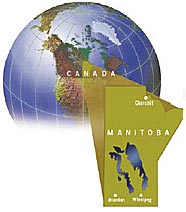Manitoba's Strategic Advantages
The Land
 The Heart of North America
The Heart of North America
This is Manitoba: the connector between east and west, north and south.
With 650,000 square km (250,000 square miles), Manitoba covers a vast area and includes four distinct geographic regions, each with its own flora, fauna and land features. One sixth of the province’s surface is comprised of more than 100,000 lakes, including Lake Winnipeg, the fifth largest freshwater lake in Canada. Vast groundwater sources (aquifers) are also easily accessible.
Like the other prairie provinces and the northern plains states, Manitoba’s climate is characterized by four distinct seasons, with warm summers and cold winters. In much of southern Manitoba, growing seasons are longer than in the agricultural regions of Alberta and Saskatchewan, with more frost-free days and more growing degree days to encourage plant growth. Winnipeg, the capital city, receives over 330 more hours per year of bright sunshine than Toronto or Montreal, and over 440 more than Vancouver.
Manitoba’s ample resources have attracted people for thousands of years.
For ages, Manitoba has been home to First Nations and Inuit peoples. The onset of the fur trade in the 1700s brought French-Canadian and Scottish traders and settlers, leading eventually to Manitoba's birth as a province in 1870 with a population of First Nations, Francophones, Anglophones and Métis. As the entry point to the Canadian West following the completion of the Canadian Pacific Railway in 1885, Manitoba attracted new Canadians from around the world. Today, Manitoba celebrates its rich history and its diversity of cultures and languages.
Manitoba is home to an abundancy of fresh water, fertile farmland, rich metal and mineral deposits, forestry resources, fish and wildlife. Manitoba's scenic lakes and rivers create vast hydroelectric power resources that are still only one-half tapped.
Quick Facts
- Manitoba’s position at the heart of North America makes it a key part of the Mid-continent Trade Corridor, connecting Canada to a central North American market of 100 million people.
- Metal mining is primarily based in northern Manitoba, which has world-class reserves of base metals (copper, zinc, nickel) and significant gold reserves. Outside the main mineral-producing areas, the geological potential for the discovery of new mineral resources in Manitoba is excellent. There are many areas yet to explore in east-central Manitoba and in the province's extreme north. Visit the GIS Map Gallery for more geological information.
- In addition to base and precious metals, Manitoba is rich in industrial minerals including tantalum, cesium, dolomite, spodumene, gypsum, salt, dimension stone, limestone, peat, lime, crushed rock, sand and gravel aggregate.
- Oil was discovered in Manitoba and has been produced since 1951. Manitoba's current oil production is located in southwest Manitoba along the northeastern flank of the Williston Basin, a sedimentary basin that also occupies portions of southern Saskatchewan, North Dakota, South Dakota and Montana.
- Forests make up about 26.3 million hectares of the province's 54.8 million hectare land base. Of Manitoba's forested lands, about 94% are owned by the province, 1% is owned by the federal government and the remaining 5% is privately owned.
- Manitoba's 100,000 lakes and numerous rivers, streams and marshes are home to important fish habitat that are the basis of sport and commercial fisheries.


